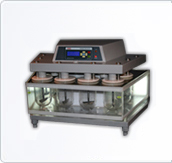| |
 |
| |
| Dissolution Tester - 6 Station |
| (Model : DR-6) |
|
|
|
| |
| DR-Series has been specifically designed as low head units to reduce clutter and maximize visibility and access in the critical sampling area above the water bath particular emphasis has been placed on those factors affecting eccentricity, alignment and centering in order to reduce the number of the procedures to validate the machine. The in-built tablet dispenser allows dropping the test samples into respective test vessel without lifting up the stirrer unit. |
| |
| The electronic speed control is provided with its micro-controller based stepper motor drive guarantees an accuracy (better than) of ±2% by automatically check up and compensating for any drift from the preset speed twice every second. |
|
|
|
|
| Salient Features: |
| |
 |
Compact, light weight stirrer unit and easy to use, rugged |
 |
Supports 6 Test Vessels |
 |
Conforms to all current USP and EP specification |
 |
User - friendly operating procedure |
 |
Ergonomically designed membrane keypad. |
 |
20X4 LCD screen with yellow backlit. |
 |
Short length shafts. |
 |
In-built tablet dispenser |
 |
Minimized and easy validation procedure |
 |
Supports single step / multi step dissolution. |
 |
Low evaporation lid. |
 |
External Circulation pump |
 |
Safety features. |
 |
Up to 12 programmable steps / sample intervals. |
 |
Validation protocol |
|
|
|
| |
| In DR-6/8/14, the bath temperature is controlled to set value by means of a heating chamber and circulation with pump, which means that the unit can be quickly removed for maintenance without compromising the operation of the whole tester. The heater controller/circulation has an accuracy of better than ±0.2ْ C thus ensuring a constant and even distribution of heat throughout the bath. |
| |
| The bath temperature can be constantly monitored using the PT 100 temperature probe provided for this purpose. An external probe is provided to monitor the temperature inside the test vessel. Provision (optional) is made for logging the actual speed, temperature and deviation with the set values, at user programmed intervals throughout the test for subsequent printing. The control is provided by a membrane keypad linked to 20X4 LCD yellow backlit LC Display, which together with modular type electronics makes instrument easy to operate and easy to service. Many users have criticized the fact that their existing tester is just too overloaded with complex and unnecessary software gimmickry for day-to-day use. For this reason, considerable attention was given in the design to ensuring that the number of actions necessary to perform a test was kept to minimum. Keeping in mind the requirement of the R & D people, we incorporated two test types: single step disso or multi step disso. |
| |
| In multi step disso user can set the number of steps required for the test and can set the RPM and time duration for each step. During the test the following information is shown on the display : Date, time, cycle number (step number), actual RPM, temperature (set, bath and external), elapsed test time. An audible alarm alerts the user on completion of each step as well as end of the test. The DR-series are provided with an optional parallel printer connection for print out of validation report comprising the date and time of the test started and end of the test, method used, serial no. of the instrument, date of validation together with the speed and temperature actual and set values at operator selectable time intervals during the test. |
| |
| Technical Specification |
| |
| Control Panel |
Controls |
Membrane Keypad |
| Display |
20character, 4 line, back-lit LCD |
| Range |
25 to 200 RPM (±2%) |
| Temperature Control |
Controller |
Microprocessor based controller with circulator |
| Range |
Ambient to -40oC (±0.3oC) |
| Test Types |
Single step dissolution |
| Multi step dissolution (1-12 steps) |
| Step Duration up to 99:59:59 |
| External Interface |
Optional parallel printer port for dot matrix printer |
| |
Print Interval up to 99 min |
|
| |
| Due to constant research and development, design and specifications may change without prior notice. |
| |
|
|
| |
|
|


